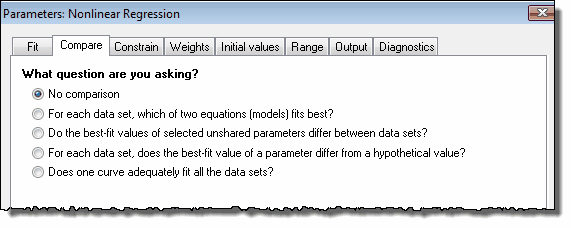What question are you asking?

When fitting biological data with regression, your main objective is often to discriminate between different models, to ask if an experimental intervention changed a parameter, or to ask if the best-fit value of a parameter differs significantly from a theoretical value. Learn more about these four kinds of comparisons. Your choice, of course, has to be based on your experimental goals.
Comparison method

Prism can perform the comparison using two alternative methods: the extra sum-of-squares F test, and using Akaike's information criteria. Use these guidelines to choose:
•In most cases, the two models will be 'nested'. This means that one model is a simpler case of the other. For example, a one-phase exponential model is a simpler case of a two-phase exponential model. Either the F test or the AICc method may be used with nested models. The choice is usually a matter of personal preference and tradition. Basic scientists in pharmacology and physiology tend to use the F test. Scientists in fields like ecology and population biology tend to use AICc.
•If the models are not nested, then the F test is not valid so you should choose AICc. Note that Prism does not enforce this. It will calculate the F test even if the models are not nested, but the results won't be useful.
The extra sum-of-squares F test only makes sense when the models being compared have different numbers of parameters, and so have different numbers of degrees of freedom. If you want to compare two models with the same number of parameters, choose the AIC method.
Check the option on the right, and before running the extra sum-of-squares F or AICc comparison, Prism checks whether both models actually fit the data. If one fit is ambiguous or flagged, Prism will choose the other without any calculation.
If you are comparing the fits of three or more models, fit individually, you can ask Prism to report the AICc with each fit. This is a choice on the Diagnostics tab.